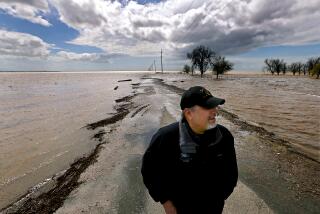California Drought Watch
- Share via
A monthly look at the water shortage
April showers did not follow the “March miracle” rains, drying up hopes that wet weather would prevail for another month. The state’s wet season is now nearly over with only 59% of normal rainfall for Sacramento River Basin. Predicted water runoff into the Sacramento River Basin has dropped to below 9 million acre feet, making this season the driest of the last five years. April snowfall in the Eastern Sierra was only 52% of normal, adding little to the snowpack that is still 15% shy of the seasonal norm.
Colorado River
The MWD has been guaranteed 1.2 million acre feet of water for the year from the Colorado River, enough to supply 2 million families for a year. Overall, the state will receive as much water as the river’s aqueduct will carry, 5.1 million acre feet.
The Bottom Line
Unless California sees a repeat of May, 1990’s, unusually high rainfall, the state will enter the dry summer months with less than two-thirds normal precipitation for the year. California’s drought status remains classified at the “critical” level. Reservoir storage has increased only slightly in April, from 42% of capacity to 45%.
Sacramento River Basin:
Precipitation in normal season: 47.5” Precipitation this season: 28.0” Driest season on record (1977): 12.32”
Eastern Sierra* Precipitation in normal season: 42.0” Precipitation this season: 28.7” Driest season on record (1977): 17.5” * Measured at Mammoth Pass
Coastal rainfall yardstick (As of April 29) A. Santa Barbara: 120% of normal B. Ventura: 110% of normal C. San Francisco: 73% of normal D. Los Angeles: 82% of normal E. San Diego: 131% of normal F. Santa Ana: 93% of normal
Water-saving tip: Skip the low-flush toilets and go right to the ultra low-flush variety. Many water agencies give $100 rebates to people who install approved ultra low-flush toilets, which use only 1.6 gallons or less compared to 3 gallons for low-flush toilets and about 6 gallons for conventional commodes.
Viewpoint “Nothing has fundamentally changed. We’ve had a problem, and we still have a problem. The drought has not gone away.”
Richard Berk of UCLA’s Center for the Study of the Environment.
After the Rains, a Return to The Status Quo:
As April opened up, water experts trudged to the mountaintops, dipped their measuring sticks into snowdrifts and optimistically trumpeted forecasts made rosy by the March storms. But as the month wore on, it became clear that, for most, the hardship had not ended:
* State Water Project deliveries increased to only 20% of normal supplies for urban users. Farmers remained cut off.
* LA DWP officials said they would hold fast to 15% cutbacks starting May 1. The Metropolitan Water District held steady at 31% cutbacks.
* Federal officials continued rationing Central Valley Project water--25% of normal deliveries for farmers and varying cuts for its few urban customers.
* Thus, the threatened Sacramento River winter chinook salmon took top priority, forcing federal officials to store up Shasta Reservoir water--instead of releasing it--to ensure the salmon’s survival.
The Drought File
More Water, Please: So far, 2,044 LA DWP customers have requested appeal forms to increase their water rations. During the ’77 drought, 70,000 appealed.
Driest in the U.S.: Bagdad, Calif., holds the U.S. record for the longest period with no measurable rain--767 days from Oct. 3, 1912 to Nov. 8, 1914. Today it is a ghost town.
Fish First: The state is required to halt pumping water at the San Luis Reservoir in May and June to protect the striped bass.
Down the Drain: Some older reverse-osmosis water filtering systems used in homes require 10 gallons of water for each gallon of pure water produced.
Sources: Department of Water Resources, Los Angeles Department of Water and Power, and the U.S. Bureau of Reclamation, Pacific Water Quality Assn. of Huntington Beach
More to Read
Sign up for Essential California
The most important California stories and recommendations in your inbox every morning.
You may occasionally receive promotional content from the Los Angeles Times.










